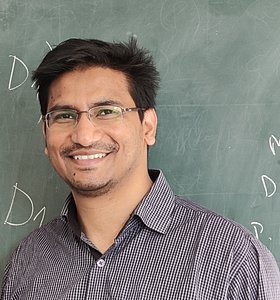2024 | On microlocalization and the construction of Feynman propagators for normally hyperbolic operators | Onirban Islam, Alexander StrohmaierZeitschrift: Communications in Analysis and GeometrySeiten: 1811-1883Band: 32 (7)Link zur Publikation
,
Link zum Preprint
On microlocalization and the construction of Feynman propagators for normally hyperbolic operators
Autoren: Onirban Islam, Alexander Strohmaier
(2024)
This article reviews the microlocal construction of Feynman propagators for normally hyperbolic operators acting on vector bundles over globally hyperbolic spacetimes and its consequences. It is shown that for normally hyperbolic operators that are selfadjoint with respect to a hermitian bundle metric, the Feynman propagators can be constructed to satisfy a positivity property that reflects the existence of Hadamard states in quantum field theory on curved spacetimes. We also give a more direct construction of the Feynman propagator for the Dirac operator on a globally hyperbolic spacetime. Even though the natural bundle metric on spinors is not positive-definite, in this case we can give a direct microlocal construction of a Feynman propagator that satisfies positivity.
Zeitschrift:
Communications in Analysis and Geometry
2023 | A Gutzwiller Trace formula for Dirac Operators on a Stationary Spacetime | Onirban IslamZeitschrift: The Journal of Geometric AnalysisBand: 33: Artikel: 57Link zur Publikation
,
Link zum Preprint
A Gutzwiller Trace formula for Dirac Operators on a Stationary Spacetime
Autoren: Onirban Islam
(2023)
A Duistermaat-Guillemin-Gutzwiller trace formula for Dirac-type operators on a globally hyperbolic spatially compact standard stationary spacetime is achieved by generalising the recent construction by A. Strohmaier and S. Zelditch to a vector bundle setting. We have analysed the spectrum of the Lie derivative with respect to a global timelike Killing vector field on the solution space of the Dirac equation and found that it consists of discrete real eigenvalues. The distributional trace of the time evolution operator has singularities at the periods of induced Killing flow on the space of lightlike geodesics. This gives rise to the Weyl law asymptotic at the vanishing period.
Zeitschrift:
The Journal of Geometric Analysis
2020 | Relative entanglement entropy of thermal states of Klein-Gordon and Dirac quantum field theories | Onirban IslamLink zum Preprint
Relative entanglement entropy of thermal states of Klein-Gordon and Dirac quantum field theories
Autoren: Onirban Islam
(2020)
An upper bound of the relative entanglement entropy of thermal states at an inverse temperature \(\beta\) of linear, massive Klein-Gordon and Dirac quantum field theories across two regions, separated by a nonzero distance \(d\) in a Cauchy hypersurface of an ultrastatic (spin-)spacetime has been computed. This entanglement measure is bounded by a negative constant times \(\mathrm{ln}|\tanh(\pi d/2\beta)|\) which signifies power law decay for asymptotic \(d\) where the exponent depends on \(\beta < \infty\).
2018 | Relative entanglement entropy for widely separated regions in curved spacetime | Stefan Hollands, Onirban Islam, Ko SandersZeitschrift: Journal of Mathematical PhysicsBand: 59Link zur Publikation
,
Link zum Preprint
Relative entanglement entropy for widely separated regions in curved spacetime
Autoren: Stefan Hollands, Onirban Islam, Ko Sanders
(2018)
We give an upper bound of the relative entanglement entropy of the ground state of a massive Dirac-Majorana field across two widely separated regions \(A\) and \(B\) in a static slice of an ultrastatic Lorentzian spacetime. Our bound decays exponentially in \(\mathrm{dist}(A,B)\) at a rate set by the Compton wavelength and the spatial scalar curvature. The physical interpretation of our result is that, on a manifold with positive spatial scalar curvature, one cannot use the entanglement of the vacuum state to teleport one classical bit from \(A\) to \(B\) if their distance is of the order of the maximum of the curvature radius and the Compton wavelength or greater.
Zeitschrift:
Journal of Mathematical Physics

